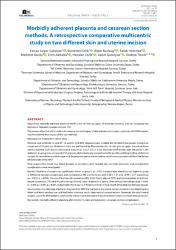Morbidly adherent placenta and cesarean section methods. A retrospective comparative multicentric study on two different skin and uterine incision

View/
Date
2021Author
Soyer-Çalışkan, CananÇelik, Samettin
Başbuğ, Alper
Hatırnaz, Şafak
Güçlü, Mehmet
Akbaba, Eren
Çelik, Handan
Güleryüz, Salim
Tinelli, Andrea
Metadata
Show full item recordCitation
Soyer-Caliskan C, Celik S, Başbuğ A, Hatirnaz S, Guclu M, Akbaba E, Celik H, Güleryüz S, Tinelli A. Morbidly adherent placenta and cesarean section methods. A retrospective comparative multicentric study on two different skin and uterine incision. Ginekol Pol. 2021 Apr 12. doi: 10.5603/GP.a2020.0192. Epub ahead of print. PMID: 33844256.Abstract
Objectives: Morbidly adherent placenta (MAP) is one of leading causes of maternal mortality, with an increasing rate because of repeated cesarean sections (CS). The primary objective of this study is to compare two techniques of skin and uterine incisions in patients with MAP, evaluating the maternal fetal impact of the two methods. Retrospective multicentric cohort study.
Material and methods: A total of 116 women with MAP diagnosis were enrolled and divided in two groups. Group one, comprised of 81 patients, abdominal entry was performed by Pfannenstiel skin incision plus an upper transverse lower uterine segment (LUS) incision (transverse-transverse), which was 2–3 cm above the MAP border, with the uterus in the abdomen. In group two, comprised of 35 patients, abdominal entry was performed by an infra-umbilical midline abdominal incision, by vertical-vertical technique, and the pregnant uterus was incised by a midline incision (vertical) from the fundus
till the border of the MAP. Total surgery time, blood loss, blood product consumption, total hospital stay, cosmetic outcomes, and postoperative complications were investigated.
Results: Total time of surgery was significantly shorter in group 1 (p < 0.05). Intraoperative blood loss was higher in group 2. Difference between preoperative and postoperative Hb and Htc levels were 3.30 ± 1.04 and 12.99 ± 5.07 respectively (p = 0.012; p = 0.033). The use of erythrocyte suspension (ES), fresh frozen plasma (FFP), and cryoprecipitate and thrombocyte suspension (TS) were found to be significantly lower in patients of group 1than vertical-vertical group (p = 0.008, p = 0.009, p = 0.001, p = 0.001, respectively). There was no difference in terms of total length of hospital stay between groups.
Conclusions: In a subgroup of patients diagnosed for MAP, the transverse-transverse incision resulted in less bleeding, less blood and blood product use, and had better cosmetic results than vertical-vertical incision. Moreover, the total time of surgery, crucial for MAP patients, seems to be shorter also in transverse-transverse incision than in vertical-vertical incision.
Source
Ginekologia PolskaVolume
92URI
https://journals.viamedica.pl/ginekologia_polska/article/view/68419https://hdl.handle.net/20.500.12809/9182

















